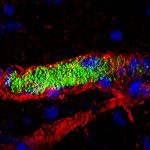Link to Pubmed [PMID] – 16864659
J. Exp. Med. 2006 Aug;203(8):1939-50
Neisseria meningitidis is a commensal bacterium of the human nasopharynx. Occasionally, this bacterium reaches the bloodstream and causes meningitis after crossing the blood-brain barrier by an unknown mechanism. An immunohistological study of a meningococcal sepsis case revealed that neisserial adhesion was restricted to capillaries located in low blood flow regions in the infected organs. This study led to the hypothesis that drag forces encountered by the meningococcus in the bloodstream determine its attachment site in vessels. We therefore investigated the ability of N. meningitidis to bind to endothelial cells in the presence of liquid flow mimicking the bloodstream with a laminar flow chamber. Strikingly, average blood flows reported for various organs strongly inhibited initial adhesion. As cerebral microcirculation is known to be highly heterogeneous, cerebral blood velocity was investigated at the level of individual vessels using intravital imaging of rat brain. In agreement with the histological study, shear stress levels compatible with meningococcal adhesion were only observed in capillaries, which exhibited transient reductions in flow. The flow chamber assay revealed that, after initial attachment, bacteria resisted high blood velocities and even multiplied, forming microcolonies resembling those observed in the septicemia case. These results argue that the combined mechanical properties of neisserial adhesion and blood microcirculation target meningococci to transiently underperfused cerebral capillaries and thus determine disease development.



